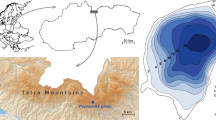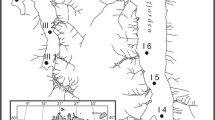Abstract
This paper presents a method for reconstructing sedimentary environments on the basis of diatoms in clastic deposits of coastal wetlands. The method includes improvements and updates of previously described approaches of coding ecological data on diatom species for computer utilization and of combining diatom species into ecological groups, which are related to specific environments.
The assessment of autochthonous and allochthonous diatoms is the major problem in the palaeoenvironmental diatom research in tide-influenced coastal areas, because the allochthonous influx by tidal currents (mainly marine planktonic and tychoplanktonic diatoms) is significant. In tidal deposits, the allochthonous diatoms often outnumber the autochthonous assemblage. Criteria for the assessment regarding which diatoms are ‘in or out of place’ are discussed.
Similar content being viewed by others
References
Admiraal, W., 1977. Influence of light and temperature on the growth rate of estuarine benthic diatoms in culture. Mar. Biol. 39: 1–11.
Admiraal, W., 1984. The ecology of estuarine sediment inhabiting diatoms. Progr. Phycol. Res. 3: 269–322.
Admiraal, W. & H. Pelletier, 1980. Distribution of diatom species on an estuarine mudflat and experimental analysis of the selective effect of stress. J. exp. mar. Biol. Ecol. 46: 157–175.
Anderson, N. J. & P. C. Vos, 1992. Learning from the past: diatoms as palaeoecological indicators of changes in marine environments. Neth. J. Aquat. Ecol. 26: 19–30.
Andrews, G. W., 1972. Some fallacies of quantitative diatom paleontology. Nova Hedwigia, Beih. 39: 285–295.
Baudrimont, R., 1974. Recherches sur les diatomees des eaux continentales de l'Algerie: Ecologie et paleoecologie. Mém. Soc. Hist. Nat. Afrique Nord, N. S. 12: 11–265.
Beyens, L. & L. Denys, 1982. Problems in diatom analysis of deposits: allochthonous valves and fragmentation. Geol. Mijnbouw 61: 159–162.
Brockmann, C., 1940. Diatomeen als Leitfossilien in Küsten-ablagerungen. Westküste 2: 150–181.
Brockmann, C., 1950. Die Watt-Diatomeen des schleswigholsteinischen Westküste. Abh. Senckenb. Naturf. Ges. 478: 1–26.
Brown, A. G. & K. E. Barber, 1985. Late Holocene paleoecology and sedimentary history of a small lowland catchment in Central England. Quatern. Res. 24: 87–102.
Cholnoky, B. J., 1968. Die Ökologie der Diatomeen in Binnengewässern. J. Cramer Verlag, Vaduz. 699 pp.
Colijn, F. & K. S. Dijkema, 1981. Species composition of benthic diatoms and distribution of chlorophyll a on an intertidal flat in the Dutch Wadden Sea. Mar. Ecol. Progr. Ser. 4: 9–21.
Denys, L., 1991. A check-list of the diatoms in the Holocene deposits of the Western Belgian coastal plain with a survey of their apparent ecological requirements. I. Introduction, ecological code and complete list. Belgische Geologische Dienst, Professional Paper 1991/2 — No 246, 41 pp.
Denys L. & C. Verbruggen, 1989. A case of drowning — the end of Subatlantic peat growth and related palaeoenvironmental changes in the lower Scheidt Basin (Belgium) based on diatom and pollen analysis. Rev. Palaeobot. Palynol. 59: 7–36.
De Wolf, H., 1982. Method of coding of ecological data from diatoms for computer utilization. Med. Rijks Geol. Dienst 36–2: 95–99.
Edsbagge, H., 1968. Zur Ökologie der marinen angehefteten Diatomeen. Bot. Gotheburg. 6: 1–153.
Florin, M. B., 1977. Late-glacial and pre-boreal vegetation in southern central Sweden. II. Pollen, spore and diatom analyses. Striae 5, 1–60.
Flower, R. J., 1982. A comparative limnological survey of Rathlin Island, Co. Antrim, with particular reference to diatoms. Proc. Roy. Irish Acad. 80B: 1–20.
Flower, R. J., 1993. Diatom preservation: experiments and observations on dissolution and breakage in modern and fossil material. Hydrobiologia 269/270: 473–484.
Hartley, B., 1986. A check-list of the freshwater, brackish and marine diatoms of the British Isles and adjoining coastal waters. J. mar. biol. Ass. U. K. 66: 531–610.
Haworth, E. Y., 1976. The changes in the composition of the diatom assemblages found in the surface sediments of Blelham Tarn in the English Lake District. Ann. Bot. 40: 1195–1205.
Heyworth, A., Kidson, C. & P. Wilks, 1985. Late-Glacial and Holocene sediments at Clarach Bay, near Aberystwyth. J. Ecol. 73: 459–480.
Hustedt, F., 1953. Die Systematik der Diatomeen in ihren Beziehungen zur Geologie und Ökologie nebst einer Revision des Halobien-systems. Sv. Bot. Tidskr. 47: 274–344.
Hustedt, F., 1955. Marine littoral diatoms of Beaufort, North Carolina. Bull. Duke Univ. Marine station, 6: 1–67.
Hustedt, F., 1957. Die Diatomeenflora des Flusssystems der Weser im Gebiet der Hansestadt Bremen. Abh. Nauw. Ver. Bremen 34: 181–440.
Hustedt, F., 1958. Diatomeen aus der Antarktis and dem Südatlantik. Deutsche Antarkt. Exped. 1938/39, Wiss. Ergebn. 2(3): 103–191.
Juggins, S., 1992. Diatoms in the Thames estuary, England: ecology, paleoecology and salinity transfer function. Bibl. Diatomol. Bd. 25: 1–216.
Krammer, K. & H. Lange-Bertalot, 1986. Bacillariophyceae. Süswasserflora von Mitteleuropa 2(1). Gustav Fischer Verlag, Stuttgart, 876 pp.
Krammer, K. & H. Lange-Bertalot, 1988. Bacillariophyceae. Süswasserflora von Mitteleuropa 2(2). Gustav Fischer Verlag, Stuttgart, 596 pp.
Miller, U., 1964. Diatom floras in the Quaternary of the Göta river valley (Western Sweden). Sver. Geol. Unders. 44: 1–67.
Moore, J. W. & C. D. McIntire, 1977. Spatial and seasonal distribution of littoral diatoms in Yaquina estuary, Oregon (U. S. A.) Bot. Mar. 20: 99–109.
Palmer, A. J. M. & J. J. Clague, 1991. Diatom assemblage analysis and sea level change, Serpentine River, British Columbia. Curr. Res., Part E; Geol. Surv. Canada, 91–1E: 109–116.
Pienitz, R., G. Lortie & M. Allard, 1991. Isolation of lacustrine basins and marine regression in the Kuujjuaq area, Northern Quebec, as inferred from diatom analysis. Géogr. phys. Quatern. 45: 155–174.
Romeyn, K. & L. A. Bouwman, 1983. Food selection and consumption by estuarine nematodes. Hydrobiol. Bull. 17: 103–109.
Round, F. E., 1971. Benthic marine diatoms. Oceanogr. Mar. Biol. Annual Rev., 9: 83–139.
Sabbe, K., & W. Vyverman, 1991. Distribution of benthic diatom assemblages in the Westerschelde (Zeeland, The Netherlands). Belg. J. Bot. 124: 91–101.
Schoeman, F. R. 1973. A systematical and ecological study of the diatom flora of Lesotho with special reference to the water quality. V&R Printers, Pretoria, 355 pp.
Simonsen, R., 1962. Untersuchungen zur Systematik und Okologie der Boden diatomeen der westlichen Ostsee. Int. Rev. ges. Hydrobiol., Syst. Beih. 1: 94–97.
Simonsen, R., 1969. Diatoms as indicators in estuarine environments. Veröffentl. Inst. Meeresforsch. Bremerhaven 11: 287–291.
Stabell, B., 1982. The response of diatom floras during Late Quaternary shore line displacement in Southern and Western Norway. Thesis, Department of Geology, University of Oslo, 323 pp.
Stabell, B., 1985. The development and succession of taxa within the diatom genus Fragilaria Lyngbye as a response to basin isolation from the sea. Boreas 14: 273–286
Sundbäck, K. 1983. Microphytobenthos on sand in shallow brackish water, Öresund, Sweden. Ph. D. Thesis Lund, 209 pp.
Sundbäck, K. 1987. The epipsammic marine diatom Opephora olsenii Möller. Diatom Res. 2: 241–249.
Thulin, B., 1987. Diatoms and paleoenvironment at Ottenby, southern Oland, SE Sweden. Striae 28: 1–61.
Van den Hoek, C., W. Admiraal, F. Colijn & V. N. de Jonge, 1979. The role of algae and seagrasses in the ecosystem of the Wadden Sea: A review. In: W. J. Wolff (ed.) Flora and vegetation of the Wadden Sea. Report 3, Stichting Veth tot Steun aan Waddenonderzoek, Leiden, 118 pp.
Van der Werff, A. & H. Huls, 1957–1974. Diatomeeënflora van Nederland, 1–10, De Hoef.
Voorrips, A. & M. A. Jansma, 1974. Pollen and diatom analysis of a shore section of the former Lake Wervershoof. Geol. Mijnbouw 53: 429–435.
Vos, P. C., 1986. De sediment stabiliserende werking van benthische diatomeeën in het intergetijde gebied van de Oosterschelde. GEOMOR-nota 86–03, Rijkswaterstaat, Dienst Getijde-wateren, Middelburg, 156 pp.
Vos, P. C. & H. de Wolf, 1988. Methodological aspects of paleo-ecological diatom research in coastal areas of the Netherlands. Geol. Mijnbouw 67: 31–40.
Vos, P. C. & H. de Wolf, 1993. Reconstruction of sedimentary environments in Holocene coastal deposits of the southwest Netherlands; the Poortvliet boring, a case study of palaeoenvironmental diatom research. Hydrobiologia 269/270: 297–306.
Vos, P. C., P. L. de Boer and R. Misdorp, 1988. Sediment stabilization by benthic diatoms in intertidal sandy shoals. In: P. L. de Boer, A. van Gelder & S. D. Nio(eds), Tideinfluenced sedimentary environments and facies. D. Reidel Publishing Company, Dordrecht: 511–526.
Williams, D. M., B. Hartley, R. Ross, M. A. R. Munro, S. Juggins & R. W. Battarbee, 1988. A coded checklist of British diatoms. Ensis Publ., London, 74 pp.
Author information
Authors and Affiliations
Rights and permissions
About this article
Cite this article
Vos, P.C., de Wolf, H. Diatoms as a tool for reconstructing sedimentary environments in coastal wetlands; methodological aspects. Hydrobiologia 269, 285–296 (1993). https://doi.org/10.1007/BF00028027
Issue Date:
DOI: https://doi.org/10.1007/BF00028027




